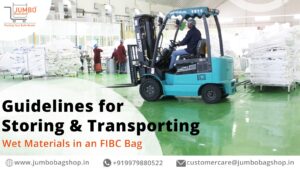Guidelines for Storing & Transporting Wet Materials in an FIBC Bag
 The FIBC Industry is growing every day, with the demand for FIBC bags increasing globally. Earlier FIBC Bags were primarily used for storing & transporting dry flowable powders & materials, and with time the application usage has grown.
The FIBC Industry is growing every day, with the demand for FIBC bags increasing globally. Earlier FIBC Bags were primarily used for storing & transporting dry flowable powders & materials, and with time the application usage has grown.
Now FIBC bags are used for multiple uses, such as chemical materials, minerals, hazardous materials, fine powders, carbon, food ingredients, green fodder, construction materials, garden waste, landscaping materials, debris, and more.
FIBC bags have become a go-to solution for several industries. FIBC bags are now used for storing, handling, & transporting wet materials. However, specific guidelines must be followed for the safe handling & transporting of wet materials in FIBC Jumbo Bags.
In this blog, we will talk you through the guidelines for storing & transporting wet materials in FIBC Bag.
Guidelines for Storing & Transporting of Wet Materials in Jumbo FIBC Bags
Storing & transporting moisture-heavy materials & high-liquid materials in any container is challenging. A tiny hole or a crack in the container can cause cross-contamination or a heavy loss of materials. By following the below guidelines, you can ensure the safe storing & transporting of wet materials in an FIBC bag.
Using Liners
FIBC bags without liners have a higher chance of liquid seeping through the bag. Hence, it is vital to use liners in FIBC Bags to prevent liquid seepage and avoid cross-contamination & loss of materials. If you are using a Coated FIBC Bag, there are still chances of liquid seeping through.
For protection & waterproofing, it is a must to use a polyethylene liner. Polyethylene liners are a cost-effective option, and you can add them on the inside layer of your FIBC Bags to prevent moisture, water & dust from seeping through the weaves of FIBC Jumbo Bags.
Determining Safe Working Loads (SWL)
Weight is one of the vital factors in storing & transporting wet materials. Wet Materials weigh more than dry flowable products. Hence, it is essential to consider the weight of both liquid & materials that you will be filling in the bag.
For wet materials, it is recommended to go with an FIBC Bag with SWL on the higher side, considering the liquid weighs more than the dry products. The best SWL for wet materials is 1,500-2,000 kgs.
However, the ideal way to determine the right SWL for wet materials is by using a density calculator & product weight guide.
Contact us if you need more clarification, and our FIBC sales representatives will assist you.
Pay attention to Discharge Options
While storing & transporting wet materials in an FIBC bag, it is a must to pay attention to the selection of the bottom discharge spout. Wet Materials often get clogged at the bottom discharge spout while wet materials are bridging. To prevent this, ensure careful discharge of wet materials.
We recommend going with a large bottom discharge spout in an FIBC Bag. The ideal option is full bottom discharge to mitigate the issue of wet materials bridging.
Opt for a Quality FIBC Bags Distributor
Opting for a quality FIBC Bag Distributor will make a huge difference. A quality distributor is not only concerned with selling the bags & earning profits. They are also concerned with the challenges you will be facing in storing & transporting materials inside an FIBC Bag.
They will provide you with set guidelines apart from the three we mentioned above in the blog to help you with the safe & secured transporting of wet & dry materials in the FIBC Bag.
Conclusion
At Jumbobagshop, we guide our customers with a set of guidelines for storing & transporting different types of materials in the Jumbo FIBC Bags. Our Sales Representative helps customers select the suitable FIBC Jumbo Bag with the correct top & bottom spout as per their requirements.
